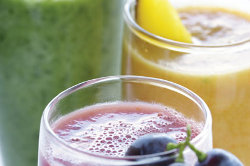Although often dairy and fruit in composition, smoothies’ perception is not limited to the above combinations. Smoothies are also often defined by thickness of texture and, sometimes, even by consumer involvement in their preparation.

|
Recent research into everything smoothie was conducted by the marketing team at Virginia Dare. In an online survey, the team hoped to better understand what defines a smoothie to consumers. Consumers were pre-screened to determine if they had consumed at least one smoothie within the last year; they were then asked a series of questions, including what comprises a smoothie, who consumes smoothies in their household, when consumed, etc.
One of the goals of Virginia Dare’s research was to establish a “flavor baseline” in the marketplace. To this end, they have reviewed and identified hundreds of smoothie flavor product offerings and have compiled a list of “well-established smoothie flavor choices,” based on widespread exposure to the consumer.
It can be said, according to Anton Angelich, group vice president–marketing, at Virginia Dare’s IFT event, “Smoothies 101,” that the in-franchise smoothie consumer “is well aware of strawberry-banana, mixed berry, mango and tropical blend smoothies.” Some of the flavor trends perceived to be “healthy” by these consumers include a variety of non-traditional ingredients, including yerba mate, guava, kiwi and mangosteen, while other “healthy” ingredients are more commonly found in the beverages (i.e., blueberry, cranberry, pomegranate, apple, banana).
Some potential perceived flavor product trends were also tracked, with their potential as smoothie applications in mind. These include: Greek yogurt, drinkable yogurts, Hispanic-inspired flavors (pina colada, guanábana, passionfruit), nectars, and flavors such as limeade and red ginger lemonade.
Another flavor guidance survey was conducted by Virginia Dare’s team with in-franchise smoothie customers. Given an extensive list of potential flavor choices for smoothies, derived from Virginia Dare’s Marketing Information Bank Brainstorming System, consumers were able to identify flavors they have not tried, but would be most interested in trying in the future. These included: apple caramel, blueberry cobbler, almond, nectarine green tea, maple, oatmeal raisin, horchata and blackcurrant, among others.
As a result of the surveys, Virginia Dare’s R&D team came up with prototype flavors that include “under-the-radar, up-and-coming flavors; healthy perception flavors; and flavors that have been pre-tested with consumers and have passed hedonic acceptance screening, and have refreshing/good taste qualities,” according to Angelich.
Those flavors are presented with accompanying reasoning/rationale for their selection. (See chart “Selected Consumer-tested Smoothie Prototypes
--Barbara T. Nessinger, Associate Editor
For more information:
Virginia Dare • Brooklyn, N.Y.
Anton Angelich • flavorinfo@virginiadare.com
718-788-1776 • www.virginiadare.com
